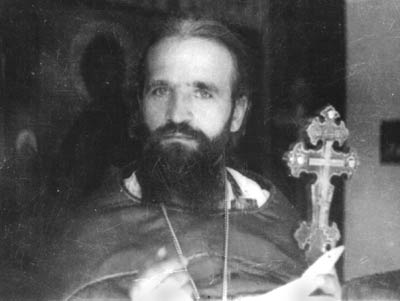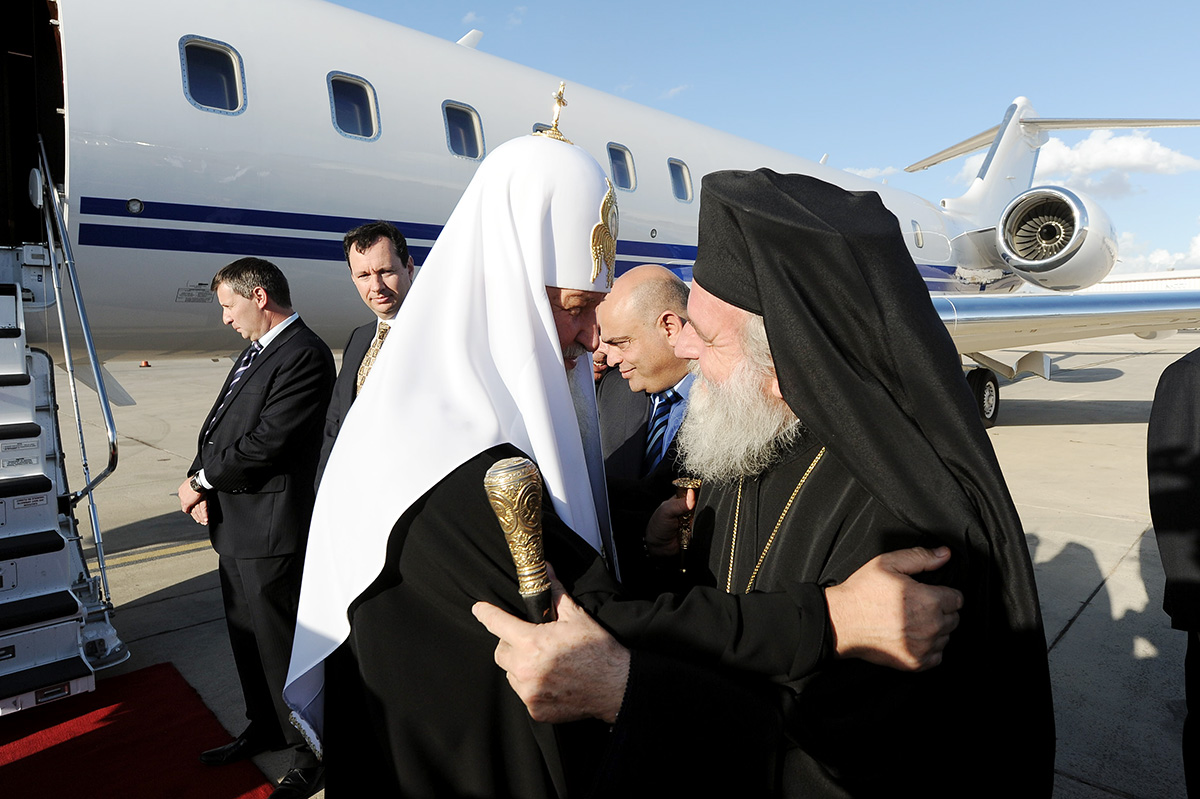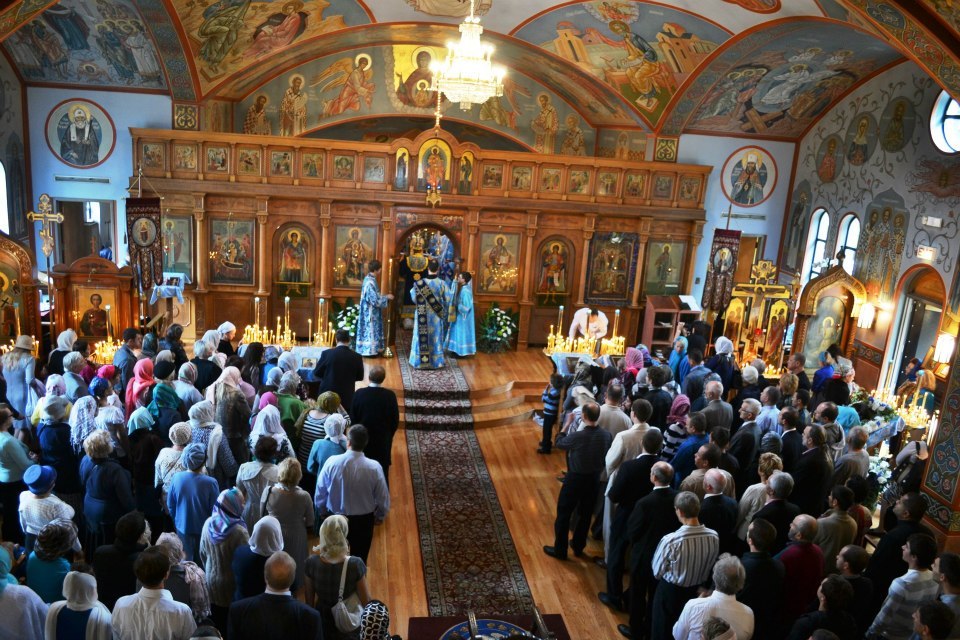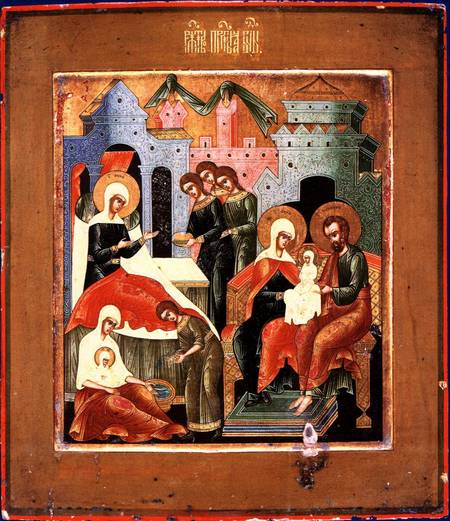Source: http://www.saintjohnwonderworker.org/open.htm
The Lord keepeth all their bones,
not one of them shall be broken
(Ps.33).
In the name of the Father and of the Son and of the Holy Spirit.
In the year 1993 from the Nativity in the Flesh of God the Word, on
the feast of St. Chariton the Confessor, September 29/October 11, the All-
merciful Lord revealed to us sinners the greatest mercy through the
uncovering of the holy and much-healing relics of the Hierarch and
Wonderworker John, Archbishop of Shanghai and San Francisco who rests
in the beautifully embellished and prayer-filled sepulchre, untouched for
twenty-seven years after burial, under the Cathedral of the Most Holy
Mother of God, Joy of All Who Sorrow.
Monday was a strict fast day for all those who took part in this holy
obedience to the Church. Many prepared by serving the Divine Liturgy and
through Confession. In the evening, after Vespers was served at the altar
of our Holy Father John of Kronstadt, Wonderworker of all Russia, in
whose canonization the ever-memorable Vladyka John took part, a blessing
was taken from the ruling Archbishop Anthony around eight o'clock in the
evening by Priest George Kurtov, Priest Alexander Krassovsky,
Protodeacon Nikolai Porshnikoff, Deacon Alexei Kotar, and Reader
Vladimir Krassovsky. After the blessing these participants entered the holy
sepulchre in order to make the necessary preparations which earlier had
been blessed by His Grace, the ruling Archbishop. In the sepulchre the
caretaker, Boris Michailovich Troyan, was already working and waiting.

A long table was prepared on which was later placed the new,
temporary, pine casket. Crowbars, hammers and other instruments were
brought in. All candle stands, analoys, and flowers were placed aside to
make more room for the work. Candles were burning on the candle stands
and the entire sepulchre was fully illumined.
After the initial preparation work was completed, and after the
exclamation "Blessed is our God," and the beginning prayers, they began to
read the Gospel from St. John over the casket, In the beginning was the
Word. Around nine o'clock in the evening during the reading of the Holy
Gospel, the ruling bishop of Western America, Vladyka Archbishop
Anthony, Archbishop Laurus of Syracuse and Holy Trinity, Bishop Kyrill of
Seattle, Archpriest Stephan Pavlenko, Archpriest Peter Perekrestov, Priest
Sergey Kotar, Hieromonk Peter (Loukianoff), Priest Paul Iwaszewicz and
Hierodeacon Andronik (Taratuchin) arrived at the holy sepulchre. All
together there were fifteen people: three hierarchs, seven priests, three
deacons, one reader, and one layman.
All three bishops, as well as all the priests, read from the Holy
Gospel.
Around 9:07, after the Gospel readings, the bishops began to serve a
full
Pannykhida which was sung by the clergy. This ended around 9:45 P.M.
Before the chanting of Memory Eternal the "Prayer Before the
Beginning
of Every Good Work" was read. Vladyka then turned to all those
present
with the following words, "Honored Vladykas, Fathers, and Brethren;
the
Lord has sent us in holy obedience to our Church in order to examine
and report concerning the honorable remains of our good instructor,
Archbishop and father, Vladyka John. Let us approach this holy work with
love for one another... with one mouth and one heart." Vladyka Anthony
then asked forgiveness of all present, then made a prostration, which
was repeated by all with the words, "God forgive you and us. Pray for
us, Holy Vladyka." The Protodeacon then
intoned "Memory Eternal."
The new, temporary, pine casket was then brought in. The inside of the
casket was lined with satin. On top of the casket was fixed a Cross. Inside
the casket was placed a new, white sheet. The casket was blessed with a
prayer.
All of the sacred objects and the brocade were taken off the holy
sarcophagus. An explanation was made to all those present concerning the
former investigation which had taken place during the night of September
17/30, the commemoration of the Holy Martyrs Faith, Hope, Love, and
Wisdom. We then proceeded to remove the cement lid from the
sarcophagus which weighed around four hundred pounds. This took place
during the compunctionate singing by all of the troparion, "Have mercy on
us, O Lord, have mercy on us." The lid was taken into the corridor outside
of the sepulchre. All those who had not been present at the initial
investigation now saw that the mantle which covered the casket was like
new.
Taking into consideration that the initial examination had shown
that the
casket was severely rusted, all present proceeded to tie the casket
in four
places because it was not known what condition the bottom was in.
During
the singing of the ekos "Thou alone art immortal," the holy casket
with the
remains of Vladyka John was very carefully raised from out of the
sarcophagus. It was initially raised higher in order to examine the
underside. Then boards were placed underneath, and the casket was
placed on the sarcophagus. During the examination of the casket, it
was
noticed that the casket had severely decomposed, and in many spots
rust
had eaten through. The casket which was a silver-gray color at the
burial
was now golden, due to the tarnished lacquer coloring. Vladyka
Anthony
then blessed Hieromonk Peter (Loukianoff) of Holy Trinity Monastery
to
open the casket. After the casket was closed at the burial, Fr.
Peter had
kept the key during these past years in memory of Vladyka John.
After a
few attempts had been made to open the lid of the casket, it became
apparent that the lock had rusted through. In spite of all careful
attempts
the lock would not open. The lock was finally broken by the
Protodeacon's
earnest prying. It was necessary to use crowbars, screwdrivers, and
pliers
to separate the lid. The casket began to break up and fall apart in
front of
our very eyes. Calling to aid the Most Holy Mother of God, we sang
"We
have no other help, we have no other hope but thee, O Sovereign
Lady..." Finally, after approximately ten minutes of work, the lid was
separated from the casket. It is difficult to describe in
words that trembling state which overcame all of us. Vladyka Anthony
lifted the half lid at the upper end of the coffin during the
singing of, "The door of compassion open to us, O blessed Theotokos,"
and the holy relics
of Vladyka John were revealed to us. The most devout feeling of
peace
and quiet reigned. Those present clearly saw the outline of the
reposed
bishop's form vested in brocade Paschal vestments which, due to
dampness and humidity, had turned a greenish color. On Vladyka's
head
was a white miter with hand-painted icons. Vladyka's face was
covered
with a white chalice cover embellished with painted Seraphims. Under
his
right hand there lay a wooden staff. The remains were sprinkled with
a
considerable amount of earth. The author of these lines who at the
time of
the burial served as a staff-bearer for the ever-memorable Savva,
Bishop
of Edmonton, recalls that before the closing of the casket His
Grace,
Vladyka Savva, sprinkled earth over Vladyka John out of a rather
large
container. At the same time another bishop, the ever-memorable
Vladyka
Leonty of Chile, poured oil from the Service of Unction on the body.
The dry, incorrupt hands of Vladyka John were raised slightly in the
air
since the lower part of the torso had sunk in. We could see skin and
nails.
The prayer rope on his left hand had decayed. The wooden cross from
Jerusalem on which was glued a paper icon, as well as the "Prayer of
Absolution" were still preserved in Vladyka's hands. His Cross and
Panaghia also remained. A small gospel book from Kiev, bound in
leather,
was still intact despite the fact that the inner binding had
disintegrated and fallen apart. There was another Cross in the casket by
the left shoulder
which fell apart when examined. A small icon of the Holy Archangel
Michael (Vladyka's patron in the world) had almost entirely
disintegrated.
All of these holy objects were then taken out of the casket and put
aside. It was known that at the burial the material lining the inside of
the casket was
a light blue; now, due to mold and dampness, it had turned green.
Vladyka Anthony crossed himself and while reading aloud the fiftieth
psalm, "Have mercy on me, O God, according to Thy great mercy..,"
very
carefully raised the chalice cover from the face of the reposed
Vladyka
John. Now the most honorable face of Vladyka John was uncovered. All
present felt deep devotion and total peace in their souls. No one
acted
surprised or expressed amazement, but with great compunction we
gazed
upon the incorrupt visage of the reposed Vladyka. The skin color was
light,
almost white. The hairs of the head and beard as well as the
eyebrows
were grey and preserved intact on the face. Even the eyelashes were
preserved. Vladyka's mouth was slightly open and teeth were visible.
The miter and inscription were preserved, though the icon of
St. John the Baptist on the left side of the miter had fallen off
and was
lying on the pillow. A clean aer was brought to cover the face. We
then
commenced to uncover the lower half of the casket which was very
rusted. It was necessary again to use crowbars and screwdrivers to
separate it. When it was opened all present saw that the lower part
of the
vestments had been fully preserved. Leather sandals were visible on
Vladyka's feet and it was noticed that on part of the left heel the
bone was
visible. As much of the feet as was visible were preserved,
revealing
darkly colored skin. It was decided that the relics could not remain
in the
old, disintegrating casket and that it would be necessary to place
them in
the newly prepared one. We began to sing the eirmosi of the Great
Canon
of Repentance of St. Andrew of Crete from the Service for the Burial
of a
Priest: "A helper and protector was He unto me for salvation...,"
"Attend,
O heaven, and I will speak...," "Behold, behold, that I am God..."
During
the singing the holy relics were prepared for transfer to the new
casket.
The table with the new casket, which was next to the fresco of the
Protection of the Most Holy Mother of God, was moved closer to the
head
of the old casket. "On the immovable rock of Thy commandments, O
Christ..." was sung while the holy relics were lifted in our hands
and
transferred. They were lowered into the new casket during the
singing of
the troparion, "Have mercy on us, O Lord, have mercy on us."

They were cleaned of the earth, dust and rust that had covered them.
As all could see and feel, the holy relics were whole and did not
fall apart.
The tendons between the bones had been preserved. The relics were
very
light. All present saw that the vestments on the underside of the
holy relics
were also totally preserved. After cleaning off the dust the holy
relics were
placed in the new casket and wrapped in a clean sheet. During the
singing
of the kontakion, "My soul, my soul, arise, why steepest thou?", the
old
casket was taken out of the sepulchre and placed in the neighboring
room.
The odor of dampness and rust disappeared and all sensed that there
was
no odor of corruption whatsoever around the relics. During this time
the
Priest Yaroslav Belikow was waiting with
his two year old son not far from the sepulchre. His son Vsvelod was
suffering from an illness of the kidneys and was brought into the
sepulchre
in order to be placed on the incorrupt hands of Vladyka John. Then
all
commenced to clean out the cement sarcophagus in which much rust
remained. During the singing of the ninth Eirmos of the Great Canon,
"A
seedless conception...," the casket with the relics was placed on
the
cement sarcophagus. The holy objects that were in the old casket
were put
in an envelope and put in the new casket. Then it was lowered into
the
sarcophagus and the lid was placed on the casket. Vladyka Archbishop
Laurus tied a cord around the casket and Vladyka Anthony sealed it
with
the diocesan seal and the mantle was placed on top. During the
singing of
"A seedless conception" the cement lid was placed back and the
sarcophagus was again covered with the brocade cover. All the other
objects, the icons, ripidi, trikiri, dikiri were returned to their
place. After this work a litiya for the dead was served and all were
anointed with oil from the ever-burning lampada on the sarcophagus.
Following the example of
Patriarch Paul of Serbia, all of the clergy sang the troparion to a
hierarch, "Teacher of Orthodoxy," which the Patriarch has sung last year
when he
visited the cathedral. Vladyka Anthony then expressed his gratitude
to all
for their labor and zeal. Around 11:15 P.M. all began to return to
their
homes in an exalted, prayerful state of trepidation, sending up
gratitude to
the Lord God for the mercy, comfort, and spiritual joy which He had
sent.
Amen.

Wondrous is God in His saints!
Holy Father John pray to God for us!
Reader Vladimir
Krassovsky

 Glory be to Jesus Christ!
Glory be to Jesus Christ!


 Father Alexis Tarasov began his life saving work in his own parish in the town of Voljsk, where he said he spent hours talking with women who were considering abortion. He expanded his pro-life work with visits to the local hospital. Then, he and other like-minded priests, established a crisis pregnancy center.
Father Alexis Tarasov began his life saving work in his own parish in the town of Voljsk, where he said he spent hours talking with women who were considering abortion. He expanded his pro-life work with visits to the local hospital. Then, he and other like-minded priests, established a crisis pregnancy center.






 We at Holy Transfiguration Mission will continue services this evening celebrating the blessed Feast of the Beheading of the Holy Glorious Prophet, Forerunner, and Baptist John with readers Vespers at 5:30 and tomorrow morning with the Hours and Typika at 8:30.
We at Holy Transfiguration Mission will continue services this evening celebrating the blessed Feast of the Beheading of the Holy Glorious Prophet, Forerunner, and Baptist John with readers Vespers at 5:30 and tomorrow morning with the Hours and Typika at 8:30.